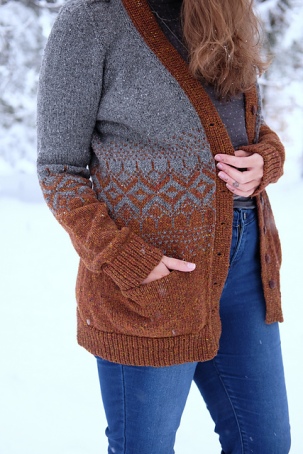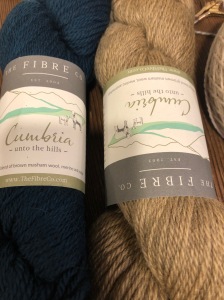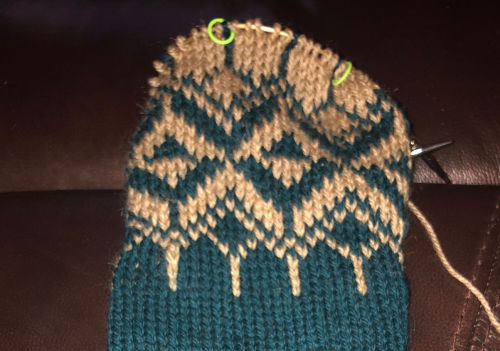 Remember how I said I wasn’t going to knit a sweater until I got to my goal weight? Who out there believed me?
Remember how I said I wasn’t going to knit a sweater until I got to my goal weight? Who out there believed me?
I lied to you, and I lied to myself. I blame Kris from KnitKnit the Studio because she’s hosting a knit-along of Bristol Ivy’s GORGEOUS Hintermost knitting pattern cardigan, and when I saw it, I immediately started justifying knitting it:
“It’s a cardigan, so I can wear it with the fronts crossed and add a belt.”
“I’ll just look at the measurements for a size 10, and knit to that.”
“I can take it in if I need to.”
All of those things might be true (hopefully the size 10 part!), but the most convincing rationale is that I love it and I’m a sweater knitter. I’ve plowed through several small projects, including a couple of baby items, socks, and a hat. I’m almost almost finished my moss-stitch cowl, and I really need a big project!

I’m not a monogamous knitter, and I like to have a big project and a small project going at all times so I can switch back and forth. One has to be social-knitting appropriate, so I can take it to knit night and knit on it in front of the TV. (And who am I kidding, I have a million UFOs I could get on, but I want that sweater!)
I have failed on a Bristol Ivy pattern before (O’Keeffe, which I talked about here), but that wasn’t Bristol’s fault. I messed up my gauge somehow, and I take full responsibility. Bristol is a fantastically inventive designer, and Hintermost is proof of that.
The techniques in this design include:
- The tubular cast-on
- Afterthought pockets
- Shaker rib
- Steeking
- Saddle shoulders
- Colorwork
So. Much. Fun. I have never done a saddle shoulder sweater, so I’m really looking forward to that. And I love colorwork, so this’ll give me a chance to explore more of that technique.
I’ve got one sleeve almost done, so I’ve already done the tubular cast-on and the shaker rib (very cool!). And of course, some colorwork. There’s not a huge amount of it in this sweater, but what there is really makes a statement. Bristol’s attention to detail includes changing the color dominance as the main colors change.
What is Color Dominance?
This is an interesting colorwork concept, wherein the foreground color shows up more than the background color. I thought I understood color dominance, but after doing some research, I realize that I had done my sleeve correctly, but just by chance.

The dominant color should be the foreground color, which in the bottom half of the colorwork portion is oatmeal, and in the top half of the colorwork is blue. I thought I should hold my dominant yarn in my left hand, which is my normal way of holding the yarn, and the non-dominant yarn should be in my right hand. This was correct, because the dominant color was being picked up from beneath the non-dominant color.
The nuts and bolts of this concept is that the yarn that comes from below the other has to travel slightly farther than the other, so the stitches are ever so slightly larger, which makes them show up a tad better. The effect can be subtle, and you’ll probably also only notice it if you change the way you’re holding the yarn and change the dominance.
Usually, it’s very important to important to knit an entire project project with the yarns in the same position, so your colorwork is even throughout.
Say you’re knitting mittens, and you change the dominance from one mitten to the other. You’ll probably notice that the foreground pattern isn’t as prominent on one mitten as it is on the other. Here’s an example:

In Hintermost, as the color emphasis changed from blue to oatmeal, I switched the yarns, carrying the oatmeal in my left hand the and blue in my right hand. This automatically changed the yarn dominance, with the oatmeal coming from below the blue.
Bristol clearly marks this change on the chart, so you know when to change.
There’s a Mistake in the Sleeve Chart!
I’m knitting the size 47½, and when I got to the chart I wasn’t working out. I thought I had the stitch count right, and I did. There are four stitches at the beginning of the round, before the repeat, and four at the end of the round, after the repeats are complete. I had 60 stitches, and the repeat is 12 stitches, so I finally realized I just needed to knit the repeat five times, which equals 60 stitches. Mischief managed.
Other Mods
The sleeve length is 21 inches for all sizes. That’s way too long for me; I need about 17 inches. To make the sleeve shorter, I’m simply decreasing faster. The pattern calls for the increase row every 6 inches, but I’m doing it every 4. I’m winging this, so I hope it works out!
That’s the story so far. I’ll keep you updated on the progress of this project.
Cheers,


That is such a great pattern! Tagging it in my wish list!!! 🙂
LikeLike
I’m really enjoying it so far.
LikeLike
Thanks, Kathleen, for explaining color dominance. I can really see the difference in the photo example. It makes sense to me now! I’m looking forward to seeing you wearing your new sweater!
LikeLike
You’re welcome! The sweater is coming along. I have both sleeves done and am working on the body. I’m loving it!
LikeLike